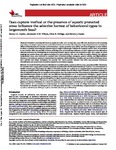Does capture method or the presence of aquatic protected areas influence the selective harvest of behavioural types in largemouth bass?
| dc.contributor.author | Cooke, ELL | |
| dc.contributor.author | Wilson, Alexander | |
| dc.contributor.author | Elvidge, CK | |
| dc.contributor.author | Cooke, SJ | |
| dc.date.accessioned | 2018-05-09T09:10:29Z | |
| dc.date.available | 2018-05-09T09:10:29Z | |
| dc.date.issued | 2017-08 | |
| dc.identifier.issn | 0706-652X | |
| dc.identifier.issn | 1205-7533 | |
| dc.identifier.uri | http://hdl.handle.net/10026.1/11428 | |
| dc.description.abstract |
<jats:p> Selectively removing fish based on particular traits, such as body size, may shift trait abundance in the remaining population, resulting in a phenomenon called fisheries-induced evolution. Recently, there is growing interest in evaluating the effects of fisheries-induced evolution on fish behaviour. Aquatic protected areas (APAs) have been designated in some habitats in efforts to prohibit harvesting and maintain natural ranges of phenotypic variation for impacted species. Here, we attempted to test whether APAs that prohibit all forms of fishing have an evolutionary influence on adult largemouth bass (Micropterus salmoides) behaviour by investigating the relationship between capture method and behavioural type. Fish, caught via active (angling) and passive (hoop net) capture techniques in both protected (70+ year old APAs in eastern Ontario) and adjacent nonprotected areas, were subjected to standard tests of boldness (refuge emergence, general activity, and flight-initiation-distance). A behavioural syndrome characterized by consistent within-individual variation and correlation of boldness behaviours (activity and refuge emergence) was present. Our results provide evidence that APAs may promote behavioural diversification and protect traits selectively targeted by recreational angling. </jats:p> | |
| dc.format.extent | 1151-1157 | |
| dc.language | en | |
| dc.language.iso | en | |
| dc.publisher | Canadian Science Publishing | |
| dc.title | Does capture method or the presence of aquatic protected areas influence the selective harvest of behavioural types in largemouth bass? | |
| dc.type | journal-article | |
| dc.type | Journal Article | |
| plymouth.author-url | https://www.webofscience.com/api/gateway?GWVersion=2&SrcApp=PARTNER_APP&SrcAuth=LinksAMR&KeyUT=WOS:000406524600001&DestLinkType=FullRecord&DestApp=ALL_WOS&UsrCustomerID=11bb513d99f797142bcfeffcc58ea008 | |
| plymouth.issue | 8 | |
| plymouth.volume | 74 | |
| plymouth.publication-status | Published | |
| plymouth.journal | Canadian Journal of Fisheries and Aquatic Sciences | |
| dc.identifier.doi | 10.1139/cjfas-2016-0192 | |
| plymouth.organisational-group | /Plymouth | |
| plymouth.organisational-group | /Plymouth/Faculty of Science and Engineering | |
| plymouth.organisational-group | /Plymouth/Faculty of Science and Engineering/School of Biological and Marine Sciences | |
| plymouth.organisational-group | /Plymouth/REF 2021 Researchers by UoA | |
| plymouth.organisational-group | /Plymouth/REF 2021 Researchers by UoA/UoA07 Earth Systems and Environmental Sciences | |
| plymouth.organisational-group | /Plymouth/Users by role | |
| plymouth.organisational-group | /Plymouth/Users by role/Academics | |
| dc.identifier.eissn | 1205-7533 | |
| dc.rights.embargoperiod | Not known | |
| rioxxterms.versionofrecord | 10.1139/cjfas-2016-0192 | |
| rioxxterms.licenseref.uri | http://www.rioxx.net/licenses/all-rights-reserved | |
| rioxxterms.type | Journal Article/Review |


